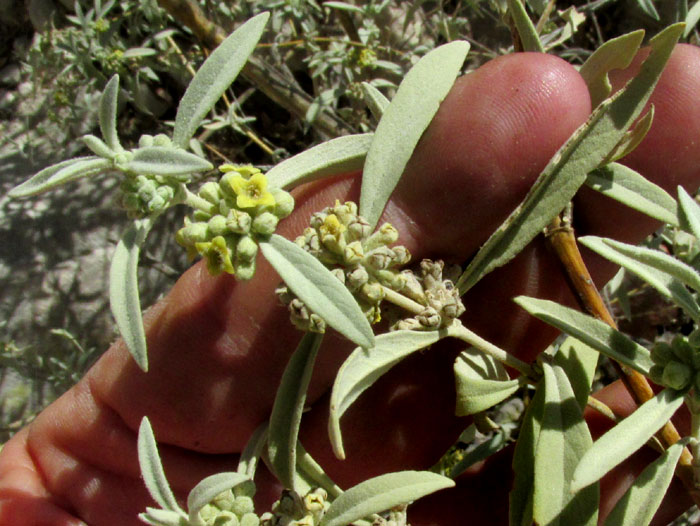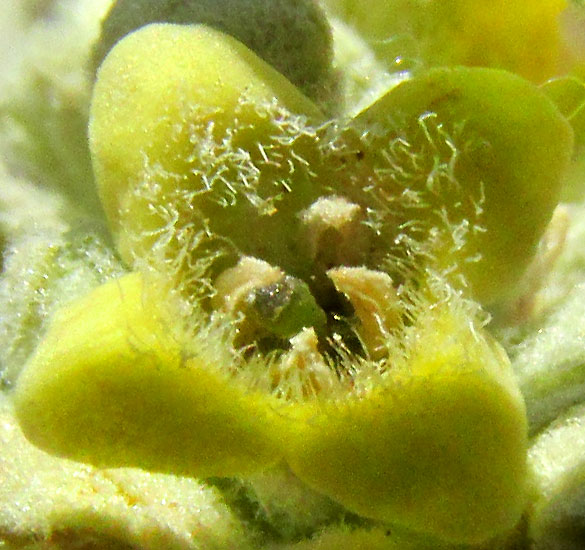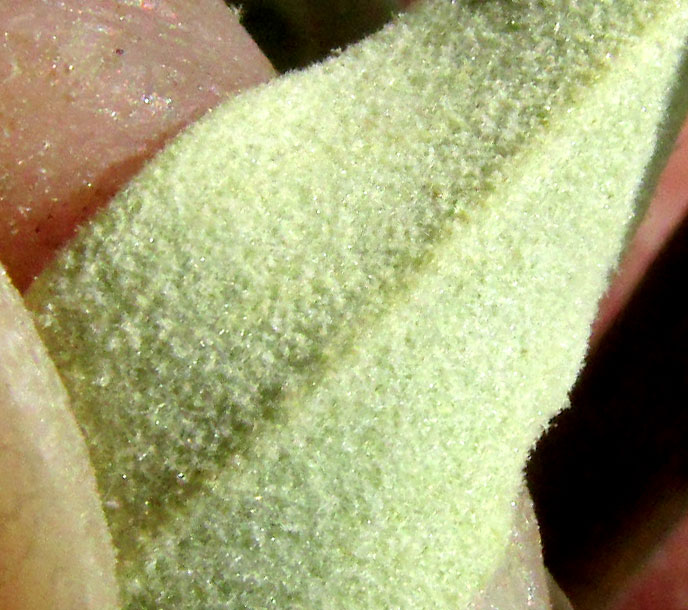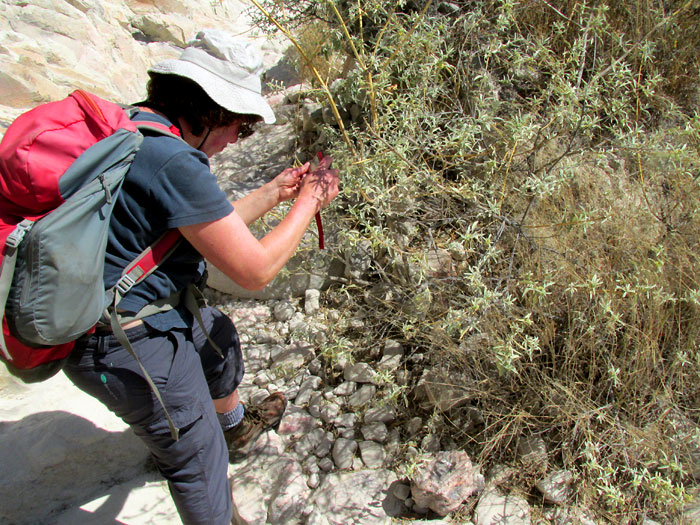Excerpts from Jim Conrad's
Naturalist Newsletter
entry from field notes dated January 17, 2023, taken on trail up the southeast-facing slope of Peña de Bernal on the northwestern side of Bernal, elevation ±2,220m (7280 ft); bedrock of intrusive, igneous dacite rock, similar to granite; Querétaro state, MÉXICO, (N20.748°, W99.949°)
TEPOZÁN BLANCO BUTTERFLYBUSH

The dry season being exceptionally rainless, with the previous rainy season never quite developing, vegetation along the steep trail up Peña de Bernal's scrubby slope was crispy dry, and most leaves still hanging on tended to be limp and fading. The above picture was taken on a much-branched bush that despite the drought clearly was doing very well, and was beginning to flower.

The tiny yellow corollas with their four lobes shared the bush's general white-hairiness. Above you can see at the corolla's opening four white stamens, each topped by a white anther grainy with white pollen. The green item surrounded by the stamens is the stigma head atop the ovary's style. None of these features, however, is as striking as the plant's very dense covering of soft, matted, white hairs, shown on a leaf's underside below:

An idea of the bush's general size and form can be seen below, with my botanizing companion, Prof. Dr. Sigrid Liede-Shumann of Germany's Universität Bayreuth, providing scale:

We've seen something like this before, with very similar clusters of tiny yellow flowers on a very hairy-white plant, but with different-shaped leaves, with the Escobilla Butterfybush, Buddleja scordioides. Also, there was the Tepozán Butterfybush, Buddleja scordioides, a fair-sized tree with similar white-hairy covering on the leaves, and bearing dried-up and blackened flowers shaped like those on our bush.
Surely here we have another butterflybush species, genus Buddleja, of the Snapdragon or Figwort Family, the Scrophulariaceae. That wouldn't be surprising, for Buddleja is a big genus, comprising about 140 species, nearly all of which are shrubs or small trees less than 5m tall (~15 feet). Sixteen Buddleja species occur in Mexico, and just in our Bajío region, which includes this location, we have six.
Our Peña de Bernal species is BUDDLEJA SESSILIFLORA, distributed in upland dry areas from Arizona and southern Texas in the US south through most of dry Mexico, except for the Yucatan, south to southernmost Mexico. In the US, the English name Rio Grande Butterflybush has been settled on, but this is an almost entirely Mexican species, and that name won't do. In Mexico it's often called the tepozán blanco, or white tepozán, the name tepozán being used for several similar-looking white-hairy bushes and small trees.
Our Tepozán Blanco Butterflybush is not highly adapted just to such exceedingly dry, exposed environments as Peña de Bernal's steep, southeast-facing slope. Rather, it occupies a wide variety of upland habitats, from mountain-top pine forests to disturbed, weedy areas and even neglected parts of cities. Most pictures on the Internet display bushes with leaves not as brilliantly white-hairy as ours. Possibly our plant's extreme hairiness reflects the species' great adaptability, the white hairs reflecting much of the almost too-much solar radiation normally baking this slope.
Beekeepers recognize our bush as a good nectar producer, and livestock graze on its leaves and stems. People collect firewood from it, and traditionally it's been used medicinally. The online Atlas de las Plantas de la Medicina Tradicional Mexicana tells us that mainly it's used for reducing fever. One approach is for fresh leaves to be smeared with lard and bicarbonate of soda and applied to the chest or the bottoms of feet. Beyond that, cures range from dealing with digestive problems to swellings of various kinds, to healing ulcers, to closing wounds, inducing sleepiness, and more.